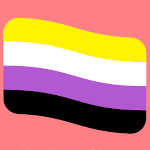International Non-Binary People’s Day Date in the current year: July 14, 2026
 International Non-Binary People’s Day is an LBGTQ+ awareness day observed annually on July 14. It was created in 2012 to celebrate people who identify outside the gender binary, as well as to raise awareness of the issues that affect them and the challenges they face on a daily basis.
International Non-Binary People’s Day is an LBGTQ+ awareness day observed annually on July 14. It was created in 2012 to celebrate people who identify outside the gender binary, as well as to raise awareness of the issues that affect them and the challenges they face on a daily basis.The term non-binary, or genderqueer, refers to a spectrum of gender identities that are outside the gender binary. In other words, non-binary people do not identify as exclusively feminine or masculine. It is an umbrella term because non-binary people may identify as agender, bigender, demigender, genderfluid, or third gender. Non-binary gender identities are usually viewed as part of the wider transgender identity.
The gender binary model assumes that there are only two genders, masculine and feminine, largely corresponding to two biological sexes, male and female. While this model is widely adopted in many societies, some societies have historically acknowledged people who don’t strictly identify as either male or female. This includes, for example, Albanian sworn virgins (women who take a vow of chastity and live as men in some parts of the Balkans) and indigenous North Americans who fulfil a traditional third-gender role in their cultures.
The term “genderqueer” precedes the term “non-binary”; it originated in the 1980s and came into wider use in the 1990s. Both termed became more popularized in the 2010s as celebrities began to publicly identify as gender non-conforming. Some non-binary people are okay with using the conventional gender-specific pronouns, but many others prefer singular “they” or other gender-neutral pronouns, or avoid using pronouns at all.
People who identify outside the gender binary have several pride flags that represent various identities. The genderqueer pride flag is lavender, white and chartreuse; the non-binary pride flag is yellow, white, purple and black; the genderfluid pride flag is pink, white, purple, black and blue; the agender pride flag is black, gray, white and green; the bigender pride flag has two shades of pink, two shades of blue, purple and white.
Genderqueer/non-binary people face discrimination on a daily basis. For example, in most societies, non-binary identities aren’t recognized legally, and people have to be identified as either male or female on official documents. Although the number of jurisdictions recognizing alternative gender identifiers has been increasing, it still isn’t very common.
Non-binary individuals often have to deal with disbelief, disrespect, disregard and condescending interactions, since many people view them as attention-seekers who are just following a trend. Other problems that many genderqueer individuals face are misgendering, misnaming and non-binary erasure.
It was decided to celebrate International Non-Binary People’s Day on July 14 because this date falls precisely in the middle between International Women’s Day (March 8) and International Men’s Day (November 19). On this day, LGBTQ+ organizations across the world host various events and activities to educate people on non-binary identities and the use of pronouns, as well as to promote non-binary visibility, awareness and understanding.
- Category
- International Observances
- Tags
- International Non-Binary People’s Day, LGBTQ+ observances, non-binary people, genderqueer people, gender nonconforming people